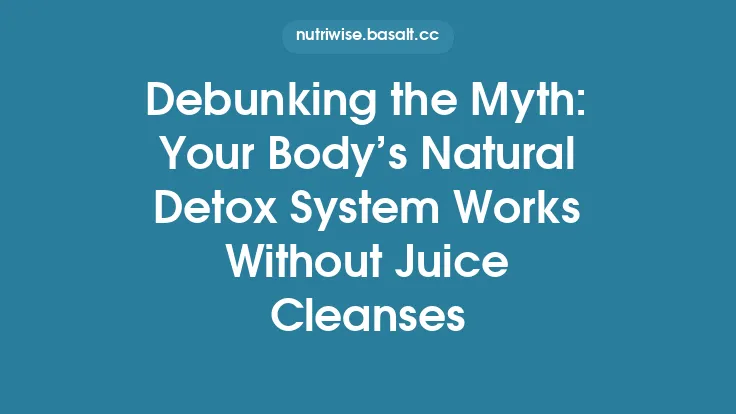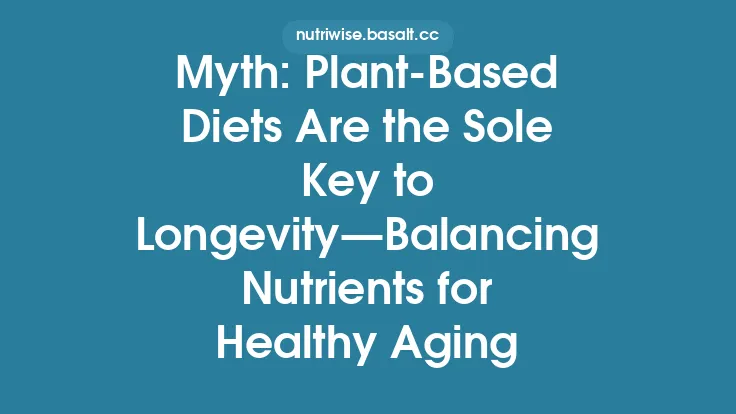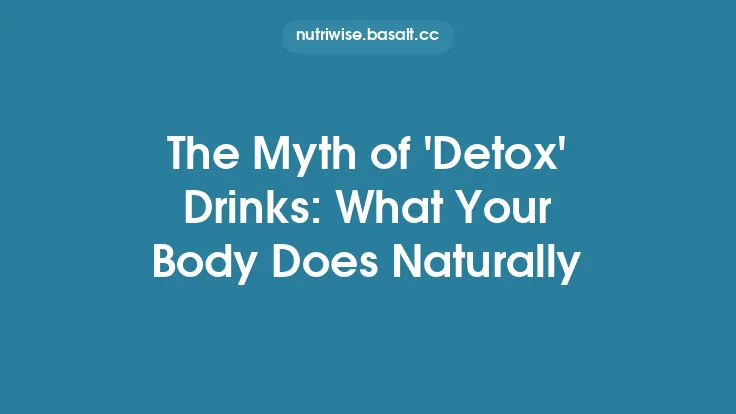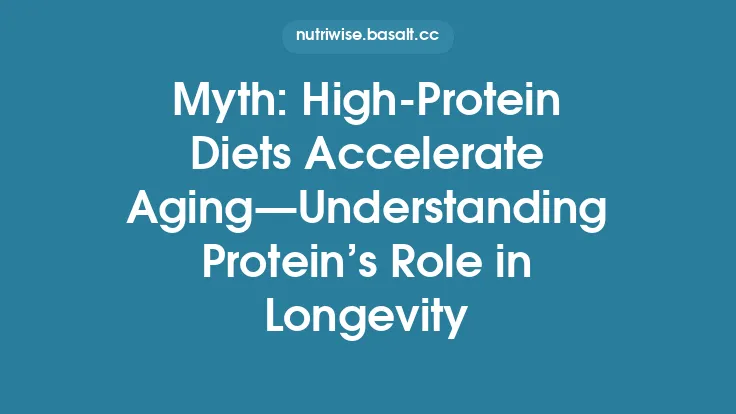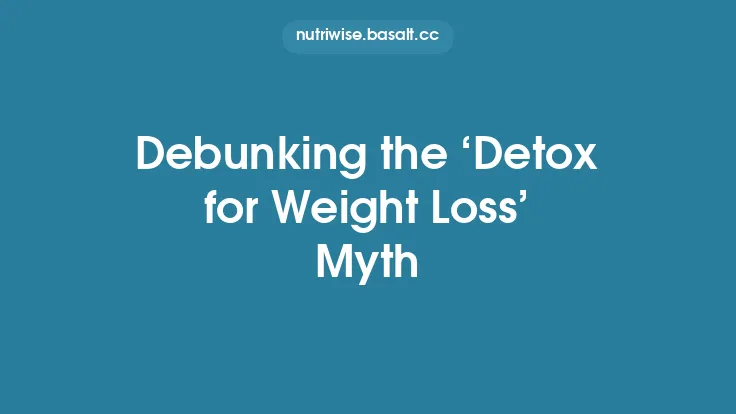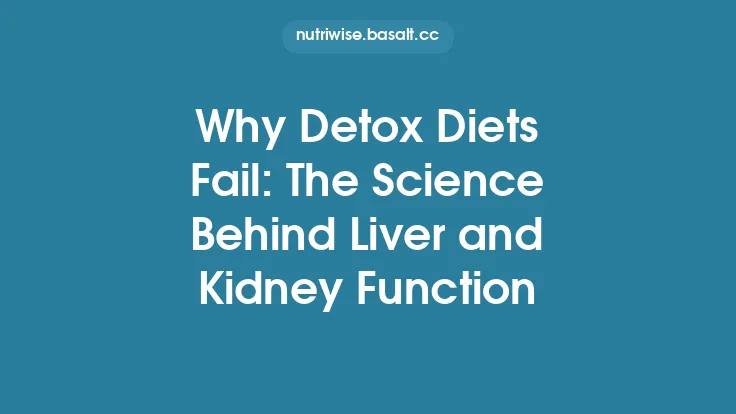The promise of a “detox”—a short‑term regimen that supposedly flushes toxins from the body, rejuvenates cells, and even turns back the clock on aging—has become a staple of modern wellness marketing. From juice cleanses and herbal teas to extreme fasting protocols, the narrative is simple: ingest the right combination of foods or supplements, and your body will shed years of wear and tear. Yet, despite the allure, the scientific evidence does not support the claim that detox diets can reset the biological processes of aging. Instead, the body already possesses sophisticated, highly regulated systems that continuously manage waste, repair damage, and maintain homeostasis. Understanding how these natural mechanisms work, and why they matter more than any short‑term dietary fad, is essential for anyone interested in genuine longevity.
What Exactly Is a “Detox” Diet?
Detox diets come in many guises, but they share a few common features:
- Restriction of Certain Food Groups – Often eliminating processed foods, animal products, caffeine, alcohol, or even all solid foods for a period.
- Emphasis on Specific “Cleansing” Ingredients – Such as lemon water, green smoothies, herbal teas, activated charcoal, or proprietary blends of herbs and fibers.
- Short‑Term Duration – Typically ranging from 24 hours to a few weeks, with the expectation of rapid results.
- Claims of Toxin Elimination – The diet is said to remove “toxins,” heavy metals, environmental pollutants, or metabolic waste that supposedly accumulate over time and accelerate aging.
The term “toxin” is rarely defined in scientific literature. In toxicology, a toxin is a substance that, at a certain dose, causes a measurable adverse effect. The human body is constantly exposed to a myriad of chemicals—some from food, air, water, and even endogenous metabolic by‑products. However, the notion that a brief dietary change can dramatically lower the body’s overall toxic burden is not supported by mechanistic evidence.
The Body’s Built‑In Detoxification Systems
Rather than relying on external “cleanses,” the human organism has evolved three primary, interlinked detoxification pathways:
| System | Primary Function | Key Organs & Molecules | How It Relates to Aging |
|---|---|---|---|
| Phase I Metabolism | Oxidative modification of lipophilic compounds to make them more water‑soluble | Cytochrome P450 enzymes (mainly in the liver) | Generates reactive intermediates; if not further processed, can cause oxidative stress and DNA damage |
| Phase II Metabolism | Conjugation of Phase I products with endogenous molecules (glutathione, sulfate, glucuronic acid) for excretion | Glutathione‑S‑transferases, sulfotransferases, UDP‑glucuronosyltransferases | Efficient conjugation reduces reactive species, protecting cellular macromolecules |
| Excretion | Removal of water‑soluble metabolites via urine, bile, sweat, and breath | Kidneys, intestines, lungs, skin | Impaired excretion leads to accumulation of waste, contributing to cellular senescence |
These processes are tightly regulated by genetic, hormonal, and nutritional signals. For example, the transcription factor Nrf2 (nuclear factor erythroid 2‑related factor 2) orchestrates the expression of many antioxidant and phase II enzymes. When oxidative stress rises—a hallmark of aging—Nrf2 activity increases, bolstering the body’s capacity to neutralize reactive species.
Aging at the Cellular Level: Damage, Repair, and Clearance
Aging is not a single event but a collection of interconnected molecular hallmarks, several of which intersect directly with detoxification:
- Genomic Instability – Accumulation of DNA lesions from reactive oxygen species (ROS) and environmental mutagens.
- Loss of Proteostasis – Misfolded or damaged proteins that escape degradation pathways.
- Mitochondrial Dysfunction – Decline in oxidative phosphorylation efficiency, leading to excess ROS.
- Cellular Senescence – Permanent cell‑cycle arrest accompanied by a pro‑inflammatory secretome (SASP).
- Altered Intercellular Communication – Chronic low‑grade inflammation (“inflammaging”).
Detoxification pathways mitigate many of these processes. For instance, glutathione (GSH) directly scavenges ROS, while phase II conjugation prevents electrophilic metabolites from forming DNA adducts. When these systems falter—due to genetic polymorphisms, nutrient deficiencies, or chronic disease—the burden of damage accelerates, manifesting as the phenotypic signs of aging.
Why Detox Diets Do Not “Reset” Aging Processes
- Short‑Term Interventions Cannot Rewire Core Metabolic Pathways
The enzymes governing Phase I/II metabolism are expressed constitutively and modulated over weeks to months by diet, hormones, and circadian rhythms. A three‑day juice fast may temporarily alter substrate availability, but it does not induce lasting up‑regulation of detox enzymes or repair mechanisms.
- Lack of Evidence for Toxin Reduction
Controlled studies measuring blood or tissue concentrations of known environmental pollutants (e.g., bisphenol A, phthalates, heavy metals) before and after detox regimens consistently show minimal change. Most “detox” products lack the binding capacity or excretory power to meaningfully lower systemic levels.
- Potential for Nutrient Deficiencies
Many detox protocols restrict protein, essential fatty acids, and micronutrients (e.g., zinc, selenium, B‑vitamins) that are crucial cofactors for detox enzymes. Prolonged deficiency can actually impair the very pathways the diet claims to support.
- Stress‑Induced Hormonal Shifts
Caloric restriction inherent in many detox plans elevates cortisol and catecholamines, which can increase proteolysis and oxidative stress—counterproductive to anti‑aging goals.
- No Impact on Core Hallmarks of Aging
Longitudinal studies tracking biomarkers such as telomere length, epigenetic clocks, or senescent cell burden have not demonstrated improvements attributable to short‑term detox diets.
What the Research Actually Shows
| Study Type | Population | Intervention | Primary Findings Related to Aging |
|---|---|---|---|
| Randomized Controlled Trial (RCT) | 45 healthy adults, 2‑week juice cleanse | 100% fruit/vegetable juice, no solid food | No significant change in plasma oxidative stress markers (F2‑isoprostanes) or inflammatory cytokines (IL‑6, CRP) compared with control diet |
| Cross‑Sectional Analysis | 1,200 participants, self‑reported detox use | Survey + blood metal analysis | Detox users had similar blood lead and mercury levels as non‑users after adjusting for fish intake |
| Animal Model (Rodent) | Mice fed high‑fat diet + intermittent fasting vs. fasting + herbal “detox” supplement | 8‑week protocol | Herbal supplement did not alter hepatic phase II enzyme expression nor improve lifespan compared with fasting alone |
| Metabolomics Study | 30 volunteers, 5‑day green smoothie regimen | Daily 1 L green smoothie | Transient increase in urinary excretion of certain polyphenol metabolites, but no reduction in endogenous waste products (e.g., urea, creatinine) |
Collectively, these data suggest that while detox‑style diets may temporarily shift gut microbiota composition or increase urinary excretion of specific phytochemicals, they do not produce measurable, lasting changes in the biological processes that drive aging.
Common Misconceptions and Potential Risks
| Misconception | Reality | Possible Adverse Effect |
|---|---|---|
| “Detox cleanses flush out heavy metals” | Heavy metal chelation requires specific agents (e.g., dimercaprol) and medical supervision | Unsupervised “detox” teas may contain laxatives leading to electrolyte imbalance |
| “Fasting resets metabolism and slows aging” | Metabolic adaptation occurs, but resetting the epigenetic clock requires sustained lifestyle changes | Prolonged fasting can cause hypoglycemia, loss of lean muscle mass, and impaired immune function |
| “All toxins are external; the body can’t handle them” | Endogenous metabolites (e.g., methylglyoxal) are also toxic and are managed by intrinsic pathways | Over‑restriction of protein can reduce availability of methyl donors needed for detoxification |
| “Detox diets are a quick fix for weight loss and longevity” | Weight loss from caloric restriction may improve some health markers, but benefits are lost if diet is not maintained | Yo‑yo dieting can increase oxidative stress and promote visceral fat rebound |
Supporting the Body’s Natural Detox Pathways—Evidence‑Based Strategies
Rather than relying on short‑term cleanses, a sustainable approach focuses on nutrient adequacy, lifestyle habits, and environmental exposure reduction:
- Consume a Diverse, Plant‑Rich Diet
- Cruciferous vegetables (broccoli, kale) provide sulforaphane, a potent Nrf2 activator.
- Allium vegetables (garlic, onions) contain organosulfur compounds that support phase II enzymes.
- Polyphenol‑rich foods (berries, tea, cocoa) enhance antioxidant capacity and may up‑regulate glutathione synthesis.
- Ensure Adequate Micronutrients
- Zinc & Selenium: Cofactors for superoxide dismutase (SOD) and glutathione peroxidase.
- B‑Vitamins (B6, B12, Folate): Required for methylation reactions that detoxify homocysteine and other metabolites.
- Vitamin C & E: Regenerate each other and protect membrane lipids from peroxidation.
- Maintain Hydration and Fiber Intake
- Water facilitates renal excretion of water‑soluble metabolites.
- Soluble fiber (e.g., psyllium, oats) binds bile acids and certain xenobiotics, promoting fecal elimination.
- Regular Physical Activity
- Exercise up‑regulates hepatic cytochrome P450 enzymes and improves circulation, enhancing delivery of nutrients to detox organs.
- Skeletal muscle contraction stimulates myokine release (e.g., irisin) that may influence mitochondrial biogenesis and oxidative stress handling.
- Prioritize Sleep and Circadian Alignment
- The liver’s detoxification enzymes exhibit diurnal rhythms; disrupted sleep can blunt their activity.
- Adequate sleep supports autophagy, a cellular “clean‑up” process that removes damaged organelles and proteins.
- Limit Exposure to Known Environmental Toxins
- Choose low‑mercury fish, filter tap water, avoid smoking, and use natural cleaning products when possible.
- While complete avoidance is impossible, reducing the load lessens the burden on endogenous pathways.
- Mindful Use of Supplements
- N‑acetylcysteine (NAC) can boost glutathione levels in individuals with deficiency, but indiscriminate high‑dose use may disrupt redox balance.
- Probiotics may aid in metabolizing certain dietary toxins, yet strain‑specific evidence is still emerging.
Practical Take‑Home Guidance
- Think Long‑Term, Not Short‑Term: Longevity is built on consistent habits that support the body’s innate detox systems, not on periodic “cleanses.”
- Focus on Whole Foods Over Fad Ingredients: Whole vegetables, fruits, nuts, and legumes provide a matrix of nutrients that work synergistically.
- Monitor, Don’t Guess: If you suspect heavy metal exposure or metabolic dysfunction, seek professional testing rather than self‑prescribed detox regimens.
- Balance is Key: Extreme restriction can impair detox enzyme cofactors; a balanced intake of macronutrients ensures the body has the building blocks it needs.
- Lifestyle Integration: Combine nutrition with sleep hygiene, regular movement, stress management, and environmental awareness for a comprehensive anti‑aging strategy.
Bottom Line
Detox diets capitalize on a compelling narrative—“flush out the bad, keep the good”—but the scientific record shows that the human body already possesses highly efficient, continuously operating detoxification and repair systems. Aging is driven by cumulative molecular damage, and while these natural pathways can be supported and optimized, they cannot be dramatically “reset” by a brief dietary gimmick. Sustainable longevity arises from a diet rich in diverse, nutrient‑dense foods, adequate hydration, regular physical activity, quality sleep, and minimized exposure to environmental toxins. By respecting and reinforcing the body’s own chemistry, we lay a far more reliable foundation for healthy aging than any short‑term cleanse ever could provide.
